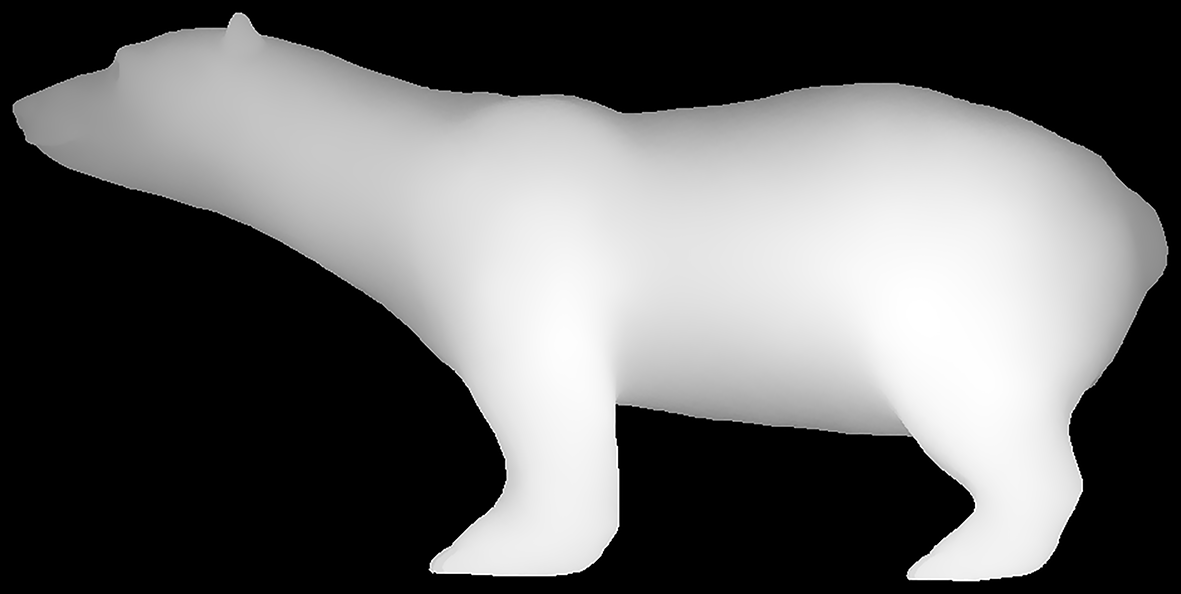
For this week's assignment we are making a molded and cast object using millable wax and the casting material of our choice. We could use an existing 3D model that we already had so I decided to use the same polar bear model I used in the 3D printing assignment.
I'm feeling pretty comfortable using the milling machine for our printed circuit boards but the process for milling depth is a bit different since the mill needs to make progressively deeper cuts for the relief. I started with a .stl file of my polar bear and turned it into a gradiated black and white .png file using fab modules. This way, the curves of the model are transformed into different gray tones.
Screen Shot 3D Model and file

Milling the wax requires two cuts: a rough cut and a finish cut. I used the preset settings from our local setup and an 1/8-inch ball nosed mill for each of these cuts.
My finish cut seemed fairly rough to me and I'm not sure if there are settings to adjust to make it a bit cleaner - something to investigate moving forward. I used a heat gut to melt the top, superficial layer a bit and that helped to smooth out the mold.
AS220 had a variety of mold-making compound mixes that we could choose from to make a flexible mold from our milled wax form. I chose to use Activa Instamold Mold-Making Compound since it had a very quick cure time and I could see the results in a matter of minutes. We had boxes of this stuff that someone had donated so that was a great perk too! I mixed according to the directions and set my timer for 8 minutes - sure enough it was firm with a similar consistency to Jello but not as fragile. It looks fairly wet when I pulled it off my milled wax form.
Front Instamold Cover

The Instamold negative mold came out nicely - it did not appear to have any air bubbles or holes that would impact the final cast object. I was pretty please given the short amount of time that it took to cure.
We did not have any of the corresponding Instamold materials in our lab to cast with ths product so I decided to experiment using Smooth-On liquid plastic. I read all the documentation for both products and didn't see any chemical incompatibilities so I decided it was probably safe to mix the two materials. I did not apply any sort of mold release to the Instamold negative because I thought the material quality of the mold inself would assist with release and if it failed, I could always make another mold quickly.

I mixed the Smooth-On parts A and B according to the written product documentation and made sure to stir gently for a decent amount of time to get all the air bubbles out. I read that the mix would heat up during the cure but figured that it would take some time for that to happen; surprisingly, it started to heat up pretty quickly and melted the plastic fork I was using to stir. I poured the liquid plastic into my Instamold and hoped for the best. According to the Smooth-On directions, it would take approximately an hour for the material to cure.
I thought I had made a decent mold without any holes but after a few minutes I could see the liquid plastic starting to leak out of some small areas of the mold. After a little more time, it looked like a chemical reaction was occuring and the liquid plastic was bubbling up and expanding in volumne. There wasn't much I could do to affect this process so I left it for the hour it needed to cure.
After an hour, I checked on my cast plastic object and slowly peeled it out of the Instamold. I was correct in thinking that the materiality of the Instamold would facilitate the release of the cast plastic. It came out easily without any apparent damage to the mold. The cast object did have the shape of the bear but it had a significant number of air bubbles in it. I don't know if those are due to poor mixing on my part or a chemical reaction between two incompatible materials. I need to do some more investigating to figure out what could have caused this kind of reaction.
Final Cast Object
CLEARLY, the cast object did not come out very well - lots of bubbles and rough surfaces. I'll have to keep experimenting with materials and see what works best for me.
Jessica Metz Fab Academy 2015